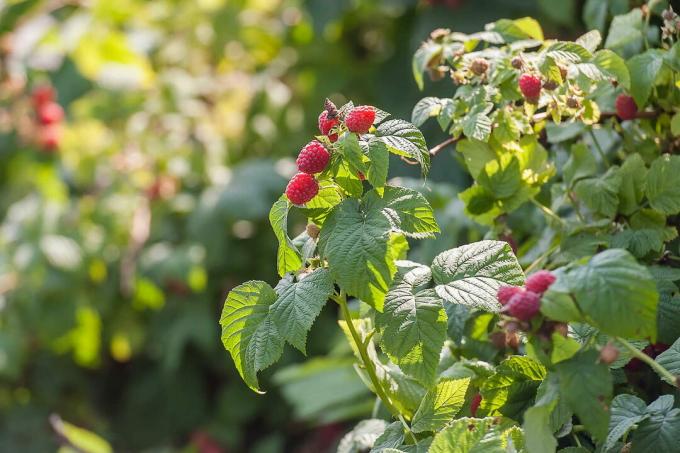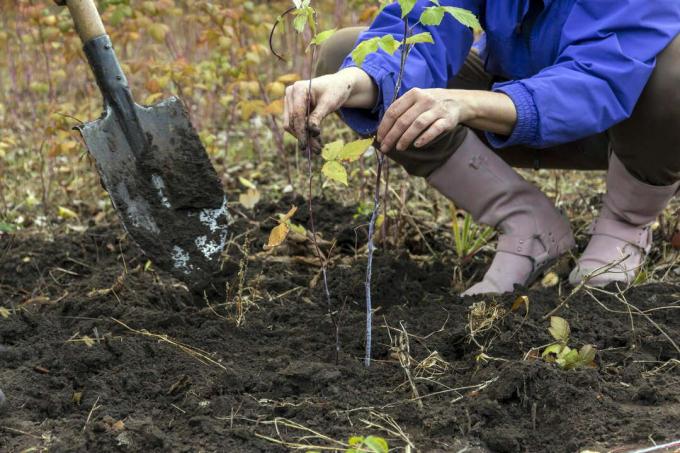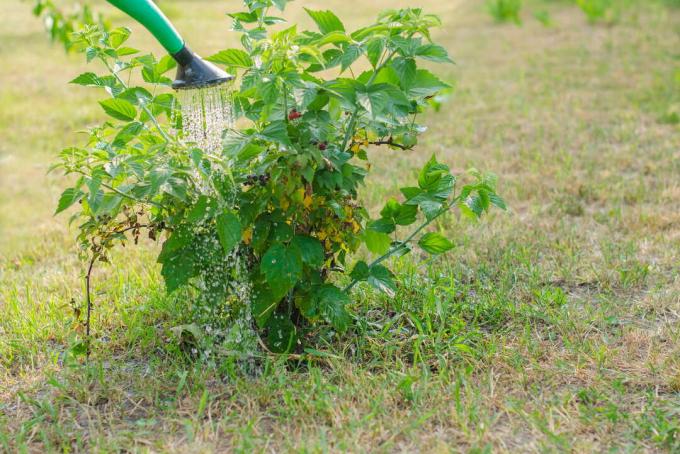Raspberries from the supermarket are usually tasteless. It is therefore worthwhile to cultivate raspberries yourself. We show what you should consider when planting raspberry bushes in your own garden.
A summer without raspberries (Rubus idaeus) is unimaginable for most. But the fruits are quite expensive in stores and the taste is not at all reminiscent of the sweet and sour raspberries that used to be nibbled from grandma's garden. If those aren't good reasons to plant raspberries in the garden yourself. Here's how to grow raspberries.
There are a few things to keep in mind when planting raspberries. Below we have summarized the most important information on the cultivation of raspberries for you - from the time of planting to the choice of location.
contents
- When do you plant raspberries?
- The perfect location for planting raspberries
-
Planting raspberries: the right approach
- This is what you need for planting raspberries
- Planting raspberries: Dig a planting hole
- Prepare raspberries before planting
- Put raspberry in planting hole
- Build a climbing aid for raspberries
- Plant raspberries in the pot
When do you plant raspberries?
Ideally, you should plant raspberries in the fall. This way, the roots have enough time over the fall and winter months to slowly establish themselves. However, it is just as possible to plant raspberries in spring. Depending on whether you plant summer or autumn raspberries, it will take a little longer before you can harvest for the first time. With summer raspberries that are planted in spring, fruit cannot be expected in the same year. With autumn raspberries, on the other hand, you can sometimes get the first ones in the fall after planting harvest raspberries.
The perfect location for planting raspberries
You should choose a sunny and sheltered place for raspberries. Draft and harsh locations with winter cold temperatures below – 15 °C are not tolerated by most varieties. In addition, the raspberry prefers soil that is nutrient-rich and permeable. There it is possible to counteract root diseases that occur on waterlogged soil. However, the soil requirement of the raspberry is rather low overall, it only grows poorly on very stony soil. Raspberry bushes form sprawling roots. Therefore, do not place your favorites too close together to avoid losses due to competition. Within a row, there should be a planting distance of at least 80 cm between the raspberries. The row spacing should also not be too narrow, so that the soil is not too compacted when watering and tending. To ensure that all plants get enough light and are adequately ventilated, you should choose a distance of at least 1.20 to 1.60 m between the individual rows. This also effectively prevents fungal diseases from spreading in the plants, because the foliage always dries quickly.
Tip: There are upright and climbing raspberry varieties. Climbing varieties should not only be planted 80 cm apart, but better have 2 - 4 m space to the next plant.

Planting raspberries: the right approach
So that raspberry variety of your choice quickly feels comfortable in your new home, there are a few things to consider. We guide you in planting your raspberry in the garden.
This is what you need for planting raspberries
To plant a raspberry you need the following materials:
- raspberry bush
- a spade
- A secateurs
- plant substrate
- A coconut mat
- A piece of string
Tip: Bare-root raspberries should always be kept moist before planting so that the sensitive root system does not dry out. For example, you can lay the roots loosely in moist soil and cover them - or wrap them with wet cloth.
Planting raspberries: Dig a planting hole
It is perfect to loosen the soil well within a radius of 1 m and then place the raspberries in the middle of this loose soil. If you only dig one planting hole, you should use the size of the root ball of the raspberry plant as a guide: the planting hole should be at least twice as deep and wide. Then fill the bottom of the hole with a little fresh soil. A special substrate for berry plants is particularly suitable here. A soil activator like ours can also be used to further promote root formation and to make it easier for the plant to grow in the new location Plantura organic soil activator to be added.
Prepare raspberries before planting
Raspberries are often available in pots as bare-root plants. In the case of bare-rooted plants, you should cut off injured roots cleanly. Before you plant raspberries with pot balls, you should score the root ball all around and then loosen it up with your hands. This promotes the formation of new roots so that the raspberry grows faster. If the root ball seems particularly dry to you, it is advisable to dip it briefly in a water bath until it is really soaked. If the rods are also unwieldy long, they are shortened to 30 to 50 cm. Otherwise, this cut is made after planting.

Put raspberry in planting hole
If the raspberry is ready to move, it can be used. The planting hole is now filled with a mixture of soil and substrate. At the same time, a suitable one can also be used Fertilizer for raspberries be incorporated.
The buds directly at the base of the shoot should be covered with soil by about 5 cm when planted. Any cavities can be closed by gently treading on the soil around the root ball. Then the plant is watered abundantly. Because raspberries do not appreciate competition from weeds at all in their growth area, a coconut mat is now placed around the trunk, or another natural mulch material is distributed.
tip: If you plant your raspberry in a warm season, you should now model a watering rim out of soil so that you can easily support the plant with enough water during the growth phase.
Build a climbing aid for raspberries
Many raspberry varieties grow very wide and form long tendrils. Depending on which variety you have chosen, a raspberry climbing aid is urgently needed and can help to give the rods stability. When building a climbing aid, it is important to use stable and weather-resistant material. If there is a garden fence nearby, you can also attach individual tendrils to it. There is even raspberry varieties (e.g. 'Aroma Queen'), which, thanks to their more compact growth, can do without any climbing aids.
Tip: Raspberries are often damaged by fungal leaf and cane diseases. If you don't have enough space to ensure a wide stand of several plants, you can install a roof against the rain. On the side, however, the shelter should be open enough to be able to dissolve a moist microclimate - a little after watering - through air movement.
Planting raspberries – summary:
- Loosen the soil within a meter radius or dig a planting hole at least twice as large as the root ball
- Put substrate and soil activator in the planting hole
- Moisten the root ball for a few minutes and free bare-rooted plants from injured roots
- Shorten rods to about 30 - 50 cm
- insert plant
- Water well
- Underlay mulch material
- If necessary, build a climbing aid

Plant raspberries in the pot
Normally, the raspberry is purely a garden plant, since it has a far-reaching root system and forms plenty of long canes. However, there are now varieties on the market that grow upright and form comparatively short shoots. Nevertheless, you should consider a few things if you want to plant raspberries in tubs on the balcony or terrace:
- Large bucket (min. 25 liters volume) to ensure sufficient space for the formation of roots.
- Planters with a drainage layer (e.g. B. coarse gravel) and drill individual holes in the bottom of the container so that the raspberry roots do not suffer from waterlogging.
- Choose a wind-protected location to prevent tipping over.
- Choose a sunny place.
- Best placed in front of a south wall.
Because the raspberry has only limited space to spread on the balcony, the harvest is limited. Therefore, to anyone who owns a garden and can create a bed, we recommend raspberries better there to plant and planters on the patio or balcony for other crops that take up less space like tomatoes, radish, Herbs, strawberries or something similar to use.
Not enough raspberries yet? Here are 10 pro tips to help cultivation of raspberries guaranteed to be successful in the garden.
